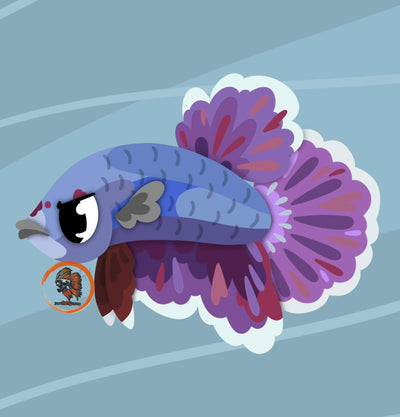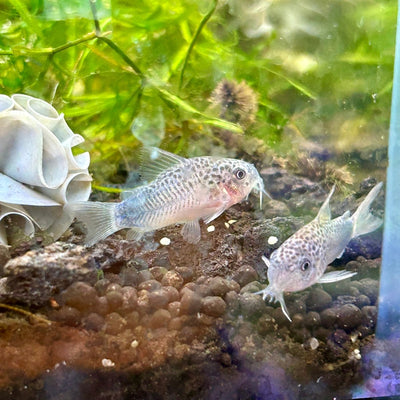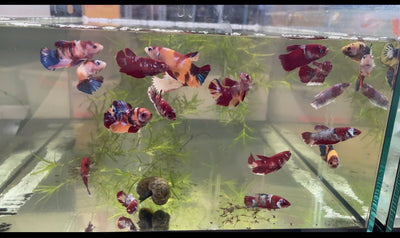Tin tức kết quả Breeding
Bài đăng trên blog
Pleco, destroy algae!
“Pleco” is a common nickname for many species of suckermouth catfish in the Loricariidae family, especially those kept in aquariums. The term can refer to a wide range of species, from the massive common pleco to the much smaller and easier-to-keep bristlenose pleco.
Primarily nocturnal creatures, they typically spend most of their waking hours hanging from the sides of the tank, seemingly crawling along rocks at the bottom, or eating some other tank feature in their mouth. The lifespan of a pleco depends on the specific pleco species, with an average of 10 to 15 years. In total, there are about 150 different species of Pleco, most of which are native to South America. However, not all species are suitable for keeping as aquarium fish in tropical aquariums. The most commonly kept Pleco species include:
Bristlenose Pleco (small Pleco fish)
The Bristlenose Pleco averages 8-13cm in size, and is popular because it keeps algae growth in the tank to a minimum. It is shorter and stockier than the common pleco, and its flat body is lined with bony plates for protection. Its body can be grey, olive, brown or black with yellow or white spots.
The round mouth and elongated lips of the Bristlenose pleco make it an excellent algae eater. They will consume more algae than shrimp or snails, and their small size makes them an ideal alternative to the common pleco. A tank of around 30 gallons (115 liters) will be suitable for the Bristlenose pleco. The most important element of a Bristlenose pleco tank is the filtration system. The fish will be constantly foraging for food and are therefore prolific predators. The water quality in your tank can quickly suffer if it has an ineffective filter.

Clown pleco (small Pleco fish
The Clown Pleco (Panaqolus maccus) is a great choice for aquarium hobbyists looking for a small, peaceful, and attractive pleco species. It’s ideal for smaller tanks and is easier to care for than larger plecos like the common pleco.

A 75 litre tank is also ideal for the Pitbull Pleco, but they do well in a community tank. Plecos are energetic feeders, so you should use a soft mud or fine gravel substrate.
The Pitbull Pleco may sink into the sand when threatened, just to cool off on the surface. Use driftwood, rocks and other decorations to provide additional hiding places if your tank has gravel. Soft mud is ideal as it will not injure their bodies.

The Rubber Lip Pleco can be distinguished by the spots on its head and it will not grow to more than 11 cm. On the other hand. On the other hand, the Rubber Pleco can grow to 18 cm

Unlike other plecos, the Zebra pleco eats a high-protein diet. They do not eat algae and will thrive on meaty meals such as brine shrimp and worms.

Most of this species can be found in northern Brazil in the tributaries of the Amazon River.
Aquarists tend to be interested in the Gold Nugget pleco because of its interesting shape and color.
In captivity they can live for about 5 years. With proper care and attention, the Gold Nugget pleco can live for 6 or 7 years.


The Sailfin pleco is a fairly large and long-lived species. It can grow to about 35cm in length and can live for more than 20 years in the wild, and 10-15 years in captivity.
The Sailfin pleco has a long, dark brown body with a large head. The body is covered with bony plates, also known as scales, except for the flat belly. It has small eyes located high on the head.

The base color for the Snowball pleco is black or dark gray, with males being dark brown with a hint of red. White or light yellow polka dots are accented on both males and females. These dots cover the entire body. They create a nice contrast to the overall dark appearance of the fish.
The subtle red tone helps to identify the pleco as male, while the female pleco is fuller and rounder.

How to raise Cory catfish - Corydora properly
Cory Catfish are peaceful, easy to care for fish that are enjoyed by aquarists of all skill levels.
Cory Catfish (also known as Corydoras, Cory Cats and Armored Catfish) are one of the most popular species in freshwater fish keeping.
Natural Habitat
Cory Catfish are known to thrive on live plants and other hiding places, so try to recreate that as best you can.
Some other things to note about the natural habitat of Cory Catfish are that they are more comfortable with sand than gravel (rock).
Shouldn't use gravel or other rough substrates as they tend to damage the body of Cory Catfish.
Personality
They live on the bottom and like to hide or rest during the day, but will forage with other fish at night. They are only seen leaving the bottom of the tank when they come to the surface for air.
The adapted gut lining means they can take in oxygen from the atmosphere. This behaviour is adapted to enable them to survive in waters with lower oxygen levels but they will still do this occasionally even in good conditions.
If this behaviour happens frequently, planting plants or air stones can provide them with extra oxygen.
They are an extremely social fish and should be kept in groups of 5 or more – watching Corydoras interact with each other is unlike any other fish.
However, some species are venomous and if highly stressed they can produce toxins that can kill everything in the tank. This means they should be self-transported and removed from the tank if they show signs of stress and quickly placed into quarantine.
Lifespan
In the wild, Cory Catfish live for 5-7 years. In captivity, Cory Catfish can live longer.
In the right conditions, Cory Catfish can live up to 12-15 years. There have even been cases of Corys living up to 20 years.
Size
Corydoras are quite small for Catfish standards. Generally, sizes range from 4-7 cm (1.5 – 2.5 inches) depending on the species.
That said, breeding females can reach up to 7.62 cm (3 inches)
Caring for Cory Catfish
These fish need a suitable habitat to thrive. It needs to be cleaned weekly, such as removing excess waste from the gravel and cleaning the tank glass. They often hide during cleaning but will emerge once the tank is cleaned. When cleaning, try not to overstress them as they will secrete toxins that can kill other species.
Change 20% of the water each week. Be sure to dechlorinate the new water and change the water slowly as disturbing the substrate.

Raising Cory catfish (Corydoras) properly is pretty rewarding—they're peaceful, social, and great for community tanks. Here’s a solid guide to keeping them happy and healthy:
🐟 Tank Setup
1. Tank Size:
Tank Size: Corydoras are small fish. Technically, a single Corydoras will only need a 10 gallon (37.8 liter) tank. Unfortunately, Corydoras are not happy alone, they need to be housed with 5 or more other Corydoras. For a tank of 5 Corydoras, a 20 gallon (75.7 liter) tank is the minimum.
-
Minimum: 10-20 gallons for a small group (6+ Corys).
-
Larger is better—Corys love space to roam.
2. Substrate:
-
Soft sand is ideal (prevents barbel damage). Avoid sharp gravel.
Unlike most freshwater fish, Corydoras are not suited to gravel – the jagged edges can damage their fins and stomachs.
Sand – the best choice when it comes to keeping Corydoras. Soft sand will not damage the Corydoras’ antennae. Choose a “sunset” yellow sand to help keep the tank looking less dirty.
While sand is definitely the best choice, it does cause problems with live plants. Sand has a low CEC (Cation Exchange Capacity) – so the roots are needed to provide your plants with the proper nutrients.

3. Plants & Decor:
-
Provide live or silk plants, driftwood, and hiding spots.
-
They like shaded areas and cozy corners.
Corydoras are not picky about plants – in fact, any will do. Some examples include: Anubias Nana, Java fern, Crypts, Hornwort, java moss are aquatic plants that do not require much light or pristine water conditions.
In addition to plants, Corydoras love to hide in driftwood and slate shelves. Feel free to be creative with your layout and placement
4. Filtration & Flow:
-
Gentle filtration—Corys don’t like strong currents.
-
Sponge filters or a filter with an adjustable flow is ideal.
🌡️ Water Parameters
-
Temperature: 72–78°F (22–26°C)
-
pH: 6.0–7.5
-
Hardness: Soft to moderately hard (2–12 dGH)
-
Keep water clean and stable—do weekly 25–30% water changes.
🧂 Tank Mates
-
Peaceful community fish (e.g., tetras, rasboras, guppies, dwarf gouramis).
-
Avoid aggressive or large predators.
-
Always keep Corys in groups of 5 or more—they’re social!
🍽️ Feeding

-
Diet: Omnivorous scavengers, but don’t just feed them leftovers!
-
Offer a mix:
-
Sinking pellets (specially for bottom feeders)
-
Frozen/live food (bloodworms, brine shrimp, daphnia)
-
Blanched veggies (zucchini, cucumber occasionally)
-
Feed once or twice a day. Remove uneaten food after a few hours to keep water clean.
🐣 Breeding (if you’re up for it)
-
Condition with high-protein foods (bloodworms, etc.).
-
Simulate rainy season:
-
Do a water change with slightly cooler water.
-
Drop temp by 2–3°F temporarily.
-
-
Look for T-shaped mating behavior.
-
Eggs will be stuck on glass/plants—move them to a breeder box or separate tank to prevent predation.
✅ Bonus Tips
-
Avoid copper-based meds—Corys are sensitive to copper.
-
Watch for barbel erosion (often caused by poor substrate or water quality).
-
Keep the tank well-oxygenated—they gulp air at the surface occasionally.
The most common wild betta species
Here are a few of the most common wild betta species that are often available in the aquarium hobby:
-
Betta splendens (Wild-type):
-
The wild-type betta is the ancestor of the common betta used in fishkeeping. These wild bettas usually have a more muted coloration compared to the vibrant colors of their domesticated counterparts. They typically have shorter fins, and males have a less dramatic, more subdued appearance.
-


-
-
Betta imbellis:
-
Known for their peaceful temperament, these bettas are often called "peaceful bettas" and are much less aggressive than their more famous relatives. They have beautiful iridescent colors, often with blue, green, and red hues.
-



-
-
Betta mahachaiensis:
-
This species is quite rare in the hobby and is known for its striking blue and red coloration. Betta mahachaiensis is usually smaller and has a more slender body compared to other species.

-
-
Betta coccina:
-
Often called the "scarlet betta," this species has vibrant red colors and smaller fins. They are known for their peaceful nature and are smaller compared to the more aggressive bettas.

-
-
Betta uberis:
-
This species has a more subtle coloration with shades of brown and a little iridescence. They are less commonly found in the hobby but are prized by collectors who want a wild-type betta with a unique look.

-
-
Betta channoides:
-
A species that is a little less common, but known for its more elongated body and beautiful coloration. They have a striking mix of blues, greens, and reds, and they can be somewhat shy compared to more aggressive betta species.
-

7. Betta Alien - Bettas with very unique colorations like metallic or iridescent hues that stand out, especially those with unusual color shifts such as neon greens, blues, or even combinations that seem almost unnatural or "alien" in appearance.
-


-
Wild bettas are typically a little more challenging to keep than the standard domesticated bettas, especially when it comes to water quality and tank mates. Many wild species are adapted to specific environmental conditions, so it's important to research their care needs carefully.
What species can bettas be kept with?
Betta fish are stunning, but their aggressive nature, especially males, makes choosing tankmates a bit tricky. However, there are a few species that can generally coexist with Bettas under the right conditions. Here are some options that might work:
1. Other Betta Fish (Females)
-
Betta females can sometimes live together in what’s called a "sorority," but they should be kept in a group of 4 or more to spread out aggression. However, sororities require careful monitoring, as even females can become territorial with each other.
-
It’s important to have a spacious tank (at least 20 gallons) and plenty of hiding spots to reduce conflict.

2. Corydoras Catfish
-
These peaceful bottom-dwellers are a good match for Bettas. Corydoras are calm, slow-moving fish that don’t compete for attention or space with the Betta, and they stay out of the Betta’s line of sight. Just make sure to have a tank with enough space and decorations.

3. Neon Tetras
-
These small, peaceful fish are generally compatible with Bettas. Their size and speed make them less likely to trigger aggression from a Betta. However, be cautious with other fish that have long fins, as Betta fish might target them.

4. Kuhli Loaches
-
These slender, eel-like fish are bottom dwellers and tend to stay out of the Betta’s territory. Their peaceful nature and nocturnal habits help them avoid conflict. They do well in groups and help keep the tank clean, which is a bonus!

5. Otocinclus Catfish (Otos)
-
These tiny algae eaters are peaceful and live in the lower part of the tank, so they are less likely to provoke a Betta. They’re excellent tank mates for keeping algae in check and don’t pose a threat to the Betta.

6. Ghost Shrimp or Amano Shrimp
-
Ghost Shrimp and Amano Shrimp are often safe with Betta fish as long as they aren’t too small. Bettas may chase or harass shrimp, but they typically won't cause harm unless the shrimp are very small or weak. Larger, robust shrimp like Amanos are less likely to be eaten or attacked.

7. Snails
-
Snails, such as Apple Snails or Nerite Snails, are generally compatible with Bettas. They won’t compete with the Betta for space or territory, and they can help clean up algae and leftover food.


8. Harlequin Rasboras
-
These peaceful, small schooling fish do well with Betta fish, as they’re quick swimmers and tend to stay in the middle or upper parts of the tank. The Betta will usually ignore them as long as the tank is large enough for all species to have their own space.

9. Platies (in certain cases)
-
While platies are generally peaceful, it's essential to keep an eye on them if you're introducing them to a Betta tank. In many cases, the Betta may tolerate platies, especially if they have short fins and don't resemble other Betta males.

10. African Dwarf Frogs
-
These small, aquatic frogs are slow-moving and spend most of their time at the bottom of the tank, where they’re out of the Betta's way. They don’t compete with Bettas for food, as they’re primarily bottom feeders. However, make sure to monitor them since Betta fish can sometimes view small creatures as prey.

Tips for Choosing Tankmates for Betta Fish:
-
Size and Speed: Small, slow-moving fish with long fins or bright colors are more likely to trigger aggression in Bettas.
-
Avoid Long-Finned Fish: Betta fish tend to attack fish with long, flowing fins, as they resemble their own and may spark territorial behavior.
-
Tank Size: A larger tank (at least 20 gallons) provides more space for all inhabitants and helps minimize aggression.
-
Add Tankmates Slowly: Introduce new fish gradually and observe interactions closely. You might need to separate the Betta if aggression occurs.
Would you like more help setting up a tank with specific fish or need suggestions for a Betta-friendly community setup?








